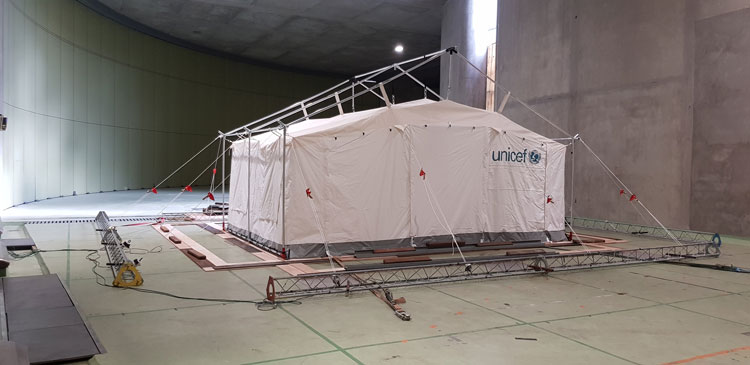Designing for disaster: how UNICEF created a tent to deal with the changing climate
An average of 4,650 tents are produced for the UN agency each year, facing every weather condition known to man – here, Design Week explores the innovation process undertaken to modernise the structures.
From classrooms in 40-degree heat, to hospital wards providing post-disaster relief and emergency nutrition facilities, children’s humanitarian organisation UNICEF’s emergency tents have to be many things to many people.
For two decades, the UN agency’s relief operations across the world were housed in the same basic structure – a large versatile space that could be adapted to field workers’ needs in any given situation.
But having been designed 20 years ago, today’s increasingly unpredictable climate conditions were proving a challenge. Stronger winds than ever cause anchoring systems to fail; rising temperatures make it far too hot to sit inside.
After five years in development, UNICEF has now unveiled its solution to the changing world, a product it calls the High Performance Tent.

“Used by everyone for everything”
In 2014, a global needs assessment conducted by UNICEF’s Copenhagen-based innovation centre revealed just how relied upon the previous tent design had become, but also how far it needed to be improved.
“UNICEF multipurpose tents were really being used by everyone for everything,” UNICEF Supply Division innovation project manager Bo Strange Sorensen tells Design Week. “But neither were they up to scratch and were beginning to get in the way of our field workers operating classrooms, hospitals and warehouses.”
Researching what a new tent would need to look like, Sorensen’s team gathered a list of requirements from stakeholders around the world. All in, it totalled more than 1,000 criteria.
“There were so many things this tent needed to be, and many of them were contradicting,” he says. “It had to be cool in warm weather and warm in cool weather; it had to be structurally sound, but also simple enough that someone who had never seen a tent could build it.”

“Understanding the UNICEF use case”
With such a lengthy list of requirements, Sorensen explains that UNICEF’s usual method of procurement and innovation – giving industry suppliers and manufacturers specific details by way of a Target Product Profile (TPP) design brief and then procuring applicants – was quickly decided against.
“The TPP we wrote was so complex, we realised we needed to be a part of the research and development process, so we decided on something we called co-creation.”
Where a normal procurement would see the UNICEF innovation team lay out exactly what it needed from a product, and subsequent suppliers competing on price, Sorensen admits the team had no idea what they were looking for when it came to the tent redesign.
A number of manufacturers were therefore invited to co-create prototypes. According to Sorensen, these were then consistently checked against field conditions, including hurricane-level winds and sub-zero temperatures at the Jules Verne Wind Tunnel in France. Those that didn’t match up, were dropped. It was, according to Sorensen, a “very competitive, but very transparent process”.
“At each stage, we were left with better products,” he says. “By bringing designers and manufacturers into the field, all of a sudden they understood the UNICEF use case better, and how important these tents really were.”

Balancing requirements
“With this new co-creation process, it wasn’t about us sending out specifications,” Sorensen says, “instead we put forward the performance targets we wanted and let the designers decide how to get there.”
For all involved, it was a case of balancing requirements and budgets effectively. With some natural disasters requiring upwards of 500 tents in on go, manufacturing costs need to be kept as low as possible, he adds.
He points to the tension between material durability and price as an example: “If you want to use a heavier metal frame for its strength, it isn’t simply a case of how much that raw material will cost.
“You’ll also have to consider how much more it will cost to ship somewhere – sure, if you were able to spend £10,000 per tent, you’d be able to meet all the requirements easily, but we obviously couldn’t do that.”

The High Performance Tent
The resulting High Performance Tent supposedly ticks all 1,000 boxes. Among the new features are a new anchoring system that keeps the structure well-secured in all soil types and weather conditions; straighter walls that provide “20 per cent more usable floor space”; a three-layered window system; and a built-in shade net.
More specialised use cases have also been designed in. Electrical and solar kits and hard flooring can be added to tents being used as hospitals. A soft inner liner can be added for more comfort in children-focused spaces.
According to Sorensen, there are actually three winning designs, which have been created by three different manufacturers.
“In any number of emergencies, we have to be able to keep up with demand, so we simply cannot rely on just the one manufacturer, which might go bankrupt or not be able to source raw materials,” he says, citing the 720 tents that were ordered after the devastating typhoons that hit the Philippines last year.
“So you’ll notice a few discrete differences among the models, but all satisfy our lengthy list of requirements.”
The project has been met with praise across UNICEF’s field work projects. Sorensen ends: “This has been one of the oldest projects in our pipeline – it’s not every day you get to launch a new innovation project, but we are excited to see the difference this one will make.”
-
Post a comment





